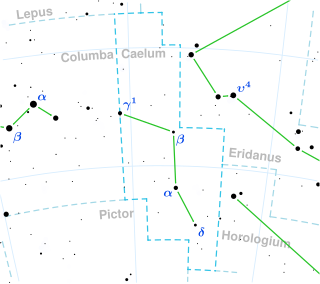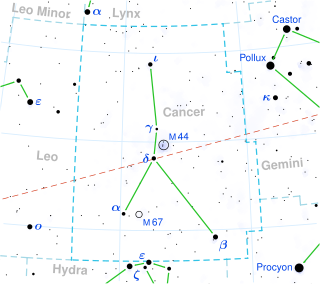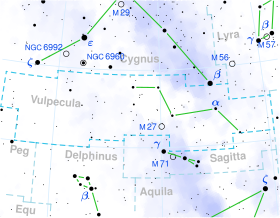
Nu Caeli is a yellow-white hued star in the constellation Caelum. It has an apparent visual magnitude of 6.07, which indicates it is near the lower limit on brightness that is visible to the naked eye. According to the Bortle scale, the star can be viewed from dark suburban skies. Based upon an annual parallax shift of 20.3 mas as seen from Earth, this star is located 161 light years from the Sun.

23 Vulpeculae is a triple star system in the northern constellation of Vulpecula. It is visible to the naked eye as a faint, orange-hued star with an apparent visual magnitude of 4.52 and it is located approximately 327 light years away from the Sun based on parallax. The system is moving further from the Earth with a heliocentric radial velocity of +1.47 km/s.

15 Vulpeculae is a variable star in the northern constellation of Vulpecula, located approximately 243 light years away based on parallax. It has the variable star designation NT Vulpeculae; 15 Vulpeculae is the Flamsteed designation. It is visible to the naked eye as a faint, white-hued star with a typical apparent visual magnitude of 4.66. This object is moving closer to the Earth with a heliocentric radial velocity of −26 km/s.

1 Vulpeculae is a class B4IV star in the constellation Vulpecula. Its apparent magnitude is 4.77 and it is approximately 780 light years away based on parallax.

12 Vulpeculae is a star in the northern constellation of Vulpecula, located approximately 630 light years away based on parallax. It has the variable star designation V395 Vul; 12 Vulpeculae is the Flamsteed designation. This object is visible to the naked eye as a faint, blue-white hued star with a baseline apparent visual magnitude of 4.928. It is moving closer to the Earth with a heliocentric radial velocity of -25 km/s.
HD 225218 is a quadruple star system in the northern constellation of Andromeda. The primary component, HD 225218 A, is a giant star with a stellar classification of B9III, an apparent magnitude of 6.16, and is a candidate Lambda Boötis star. It has a fainter, magnitude 9.65 companion, HD 225218 B, at an angular separation of 5.2″ along a position angle of 171°. The primary itself has been identified as a binary star system through interferometry, with the two components separated by 0.165″. The pair, HD 225218 Aa and Ab, orbit each other with a period of about 70 years and an eccentricity of 0.515. Component B is likewise a spectroscopic binary.

Xi Leonis is a solitary star in the zodiac constellation of Leo. It has an apparent visual magnitude of 5.0 and is faintly visible to the naked eye. The distance to this star, as determined by parallax measurements, is roughly 229 light years.

V381 Cephei is a triple star system in the northern constellation of Cepheus. Its apparent magnitude is slightly variable between 5.5 and 5.7.

Zeta Chamaeleontis, Latinized from ζ Chamaeleontis, is a star located in the constellation Chamaeleon. Located around 540 light-years distant, it shines with a luminosity approximately 522 times that of the Sun and has a surface temperature of 15,655 K.

1 Camelopardalis is a double star system in the constellation Camelopardalis. Its combined apparent magnitude is 5.56 and it is approximately 800 parsecs (2,600 ly) away.

HD 102839 is a class G6Ib star in the constellation Musca. Its apparent magnitude is 4.98 and it is approximately 1,550 light years away from Earth based on parallax.

π Pavonis, Latinized as Pi Pavonis, is a candidate astrometric binary star system in the constellation Pavo. It is a white-hued star that is visible to the naked eye as a faint point of light with an apparent visual magnitude of 4.33. The distance to this object is 130 light years based on parallax, but it is drifting closer to the Sun with a radial velocity of −15.6 km/s.

Phi1 Pavonis, latinized from φ1 Pavonis, is a single star in the southern constellation of Pavo. It has a yellow-white hue and is faintly visible to the naked eye with an apparent visual magnitude of 4.75. The star is located at a distance of approximately 92 light years away based on parallax. It is drifting closer to the Sun with a radial velocity of −20 km/s.

QZ Puppis is a class B2.5V star in the constellation Puppis. Its apparent magnitude is 4.5 and it is approximately 650 light years away based on parallax.

1 Puppis is a single star in the southern constellation of Puppis. It lies in the northern part of the constellation at a distance of about 790 ly, east of Aludra in Canis Major and just north of the white supergiant, 3 Puppis. This object is visible to the naked eye as a faint, red-hued star with an apparent visual magnitude of 4.59. It is moving further from the Earth with a heliocentric radial velocity of +32.4 km/s.

HD 59890 is a class G3Ib yellow supergiant star in the constellation Puppis. Its apparent magnitude is 4.65 and it is approximately 1,360 light years away based on parallax.

HD 54893, often called A Puppis is a suspected variable star in the constellation Puppis. Its apparent magnitude is 4.83 and is approximately 860 light years away based on parallax.
HD 155448 is a quintuple star system consisting of 5 young B-type stars. With an apparent magnitude of 8.72, it is too dim to be visible with the naked eye.
36 Camelopardalis is a single star in the northern circumpolar constellation of Camelopardalis. It is visible to the naked eye as a dim point of light with an apparent visual magnitude of +5.3. Parallax measurements provide a distance estimate of approximately 710 light years away from the Sun, and it is drifting away from the Earth with a radial velocity of −1.15 km/s.

HD 33541, also known as HR 1683, is a white-hued star located in the northern circumpolar constellation Camelopardalis. It has an apparent magnitude of 5.83, making it faintly visible to the naked eye. Gaia DR3 parallax measurements imply a distance of 358 light years and it is currently receding with a heliocentric radial velocity of 9.9 km/s. At its current distance HD 33541's brightness is diminished by 0.16 magnitudes due to interstellar extinction and it has an absolute magnitude of +0.58.









